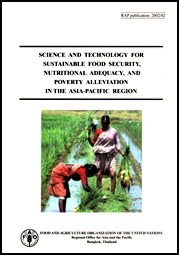
FOOD AND AGRICULTURE ORGANIZATION OF THE UNITED
NATIONS
Regional Office for Asia and the Pacific
Bangkok, Thailand

RAP publication: 2002/02
R.B. Singh
Assistant Director-General
and FAO Regional Representative for Asia and the
Pacific
|
|
FOOD AND AGRICULTURE ORGANIZATION OF THE UNITED
NATIONS |
|
The designations employed and the presentation of material in this information product do not imply the expression of any opinion whatsoever on the part of the Food and Agriculture Organization of the United Nations concerning the legal status of any country, territory, city or area or of its authorities, or concerning the delimitation of its frontiers or boundaries. All rights reserved. Reproduction and dissemination of
material in this information product for educational or other non-commercial
purposes are authorized without any prior written permission from the copyright
holders provided the source is fully acknowledged. Reproduction of material in
this information product for resale or other commercial purposes is prohibited
without written permission of the copyright holders. Applications for such
permission should be addressed to the Chief, Publishing and Multimedia Service,
Information Division, FAO, Viale delle Terme di Caracalla, 00100 Rome, Italy or
by e-mail to [email protected] |
© FAO, 2002
|
FOR COPIES WRITE TO: |
Meetings and Publications Officer |
|
|
FAO Regional Office for Asia and the Pacific |
|
|
Maliwan Mansion, 39 Phra Atit Road |
|
|
Banglamphu, Bangkok 10200 |
|
|
THAILAND |
|
|
Tel: +66 (0) 2697-4000 |
|
|
Fax: +66 (0) 2697-4445 |
|
|
|
|
|
Printed in March 2002 |
II. STATE OF FOOD AND AGRICULTURE
Food consumption and nutrition
Nexus between hunger and poverty
Demand and supply at 2015/2030
Prospects for agricultural production
III. SALIENT FEATURES OF ASIAN FARMING SYSTEMS
Enhancing yield and productivity, bridging yield gaps, and protecting yield gains
Biotechnology: exploiting the gene revolution
Information revolution: knowledge-based development
Managing natural resources: land, water and biodiversity
Environmental concerns
Managing climate change
Natural disasters: minimizing adverse impacts
VI. SCIENCE AND TECHNOLOGY POLICIES AND STRATEGIES
Paradigm shift: Towards an evergreen revolution
Investment in agriculture, agricultural sciences, and research and technology development
Pro-poor science development and technology transfer: science with a human face
Science-led agricultural diversification
Building bridges for science: strategic partnerships and regulatory framework
Globalization and liberalization: the role of science
Linking science, nutrition, and development